
Understanding Transition Sentences (For Essays and Writing with Examples)

What are transition sentences? And how do they work? Is there a correct way to use them? And an incorrect way? Understanding transition sentences is critical when writing essays, articles, or any type of logical flow.
Learn what transitional sentences are in this short guide…
What are transition sentences?
When you write an article, essay (or anything), you’ll want to write it in a logical sequence. You start with an introduction, highlight your points, and then end with a conclusion. Throughout your writing, you would be using sentences to express your thought. To make your writing effective, you need to link the sentences together in a logical way .
This is where transition sentences can be helpful.
As the name suggests, a transition sentence links the thoughts you are expressing in your writing. They make use of words and phrases that act as a bridge between different parts of your writing.
Transition sentences allow your reader to move smoothly from one section to another. Without transition sentences, your reader might not be able to understand the link between different parts of your writing.
What makes a good transition sentence?
Look at this example:
The CEO was very clear that productivity and efficiency were the two key things he would focus on. However , the legacy systems followed by the company acted as a detriment. Tech modernization was the solution that would enhance productivity and efficiency.
Sentences one and three make sense by themselves. But it is important to establish a relationship between the two. This is what the second sentence does . It acts as a bridge (or transition) between the first and third sentences. By doing so, it helps the writer communicate their ideas more effectively.
A good transition sentence would bring clarity by linking ideas expressed in the sentences before and after it. Words and phrases like ‘however,’ ‘in contrast,’ ‘for instance,’ ‘in fact,’ and ‘therefore’ can get used to help make the transition.
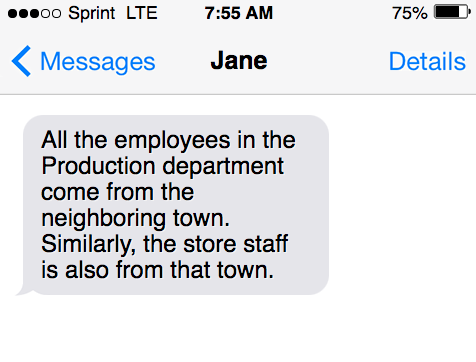
Many transition words are available to use. Choose the appropriate word for the situation.
For example, if you want to show the sequence between two sentences, you can use a word like ‘then’ or ‘after.’ If you want to emphasize a point through the transition, you can use ‘indeed,’ ‘especially,’ or ‘particularly.’
Transition words can be used at the start of the sentence ( e.g. , Surely , you are not going to go now!). It can also be used within the sentence (e.g., I rejected the job offer because the salary was lesser than my present pay ).
Here are a few tips that will help you use transition words correctly:
- When sentences within a paragraph sound abrupt or awkward, you need to use transition words to link them.
- Choose the correct transition word that is appropriate to the situation. A wrong selection can make your reader confused.
- When moving from one idea to another, use a transition word to let the reader know.
- Don’t make the mistake of overusing transition words. Too many transition words can end up making your writing look messy.
List of words for transition sentences
Some common words used in transition sentences are:
- Furthermore
- Nevertheless
- Specifically
List of phrases for transition sentences
Transition sentences would use both words and phrases as the bridge. A few phrases that are used include:
- In other words
- On the contrary
- As a result
- In the long run
- As you can see
- In the following
- In the previous
- Having established
- Most importantly
- For example/instance
- By the time
5 Examples of Transitions (Types of Transitions)
Conjunctive adverbs can be used to establish the logical link between ideas. They can be classified under five heads. It must be noted some words appear in multiple categories.
Of addition
- Additionally
- In addition
- In the same way
The following example will make this clear.
First , put a pan on the stove and heat it. Next , add oil to the pan.
In the above, first and next act as the transition and are adding on to what is being said previously.
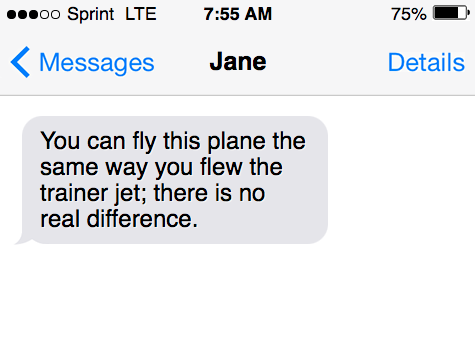
Of contrast
These words establish a contrast or difference while making the transition.
- In contrast
- Even though
- At any rate
- In spite of that
- On the other hand
The island was not the paradise we were hoping for. On the contrary , it was dirty, noisy, and had unmanageable traffic.
The above example brings out a contrast between expectations and reality.
Of comparison
- By comparison
- In the same manner
Jonathan is crazy about chess. His daughter is similarly a big fan of the board game.
In this example, the word similarly shows a comparison between father and daughter. You may note the transition word need not be at the start of the sentence. It can be placed anywhere.
These transition words are indicative of a result. It shows the result of the previous sentence/idea.
- Consequently
Their star player was suffering from a hamstring injury and could not play. Hence , their team faced a humiliating defeat on match day.
The star player’s absence resulted in the team’s defeat. The transition word ‘Hence’ in the example is the bridge between the cause/event and the result.
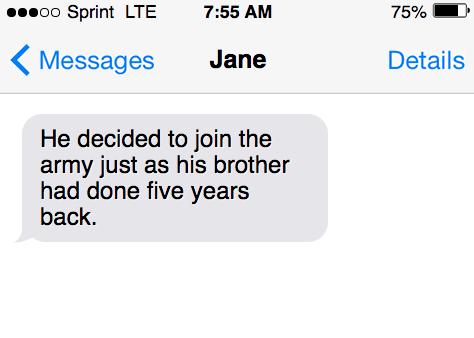
Some transition words show relationships in time. They include:
- Simultaneously
- Subsequently
The speaker will be a bit late for the talk. Meanwhile , let’s ask the participants to share their views on the program .
As the speaker will be late, there is time left. So, the participants are asked to share their views and opinions. In this example, ‘Meanwhile’ is a transition word that shows relationship to time.
Subordinating conjunctions and transition sentences
You can use a subordinating conjunction in a sentence to join a dependent clause to an independent clause .
Example: When the postman came, my dog greeted him with a volley of barks.
In this example, the word ‘when’ is the subordinating conjunction that joins ‘the postman came’ and ‘my dog greeted him …’
The subordinating conjunction serves a special purpose here. It acts as a transition between two ideas. The use of the coordinating conjunction provides a logical flow.
Example: He is smarter than you are.
In this example, “than” is the subordinating conjunction that connects ‘He is smarter’ and ‘you are.’ It provides the bridge or transition between the two clauses .
Let’s look at another example to understand this. There are two clauses – ‘The spring arrives’ and ‘my hay fever gets aggravated. A subordinating conjunction can link the two. We can use ‘As’ here. So, the sentence would now read – ‘ As the spring arrives, my hay fever gets aggravated.’
Correlative conjunctions and transition sentences
The correlative conjunction shows a correlation between two words or phrases within a sentence. They play a key role in transition sentences. The use of a correlative conjunction ensures a smooth flow between two sentences or ideas.
Example: My boss totally ignored my work. Neither my hard work nor my punctuality impressed him. So, I decided to move on and look for a new job.
In the above example, sentences one and three are independent and convey the meaning clearly. However, the second sentence acts as a transition explaining why sentence one leads to sentence two.
In the second sentence, we see the use of neither … nor. This combination of words acts as correlative conjunctions in this example.
Some other words that work as correlative conjunctions are:
- Either … or
- Neither … nor
- Whether … or
- Not only … Also
Whether you want to have dinner or prefer to skip it is entirely left to you.
The above example uses Whether … or as correlative conjunctions in the sentence.
Examples of transition sentences
Examples of transition sentences:
Communicate similarities
To communicate similarities, you can use transitional words like:
Examples of sentences where the transition word communicates similarities:
- He decided to join the army just as his brother had done five years back.
- You can fly this plane the same way you flew the trainer jet; there is no real difference.
- All the employees in the Production department come from the neighboring town . Similarly , the store staff is also from that town.
Express emphasis
Words like ‘especially,’ ‘above all,’ ‘particularly’, ‘indeed,’ in fact,’ and ‘in particular’ can be used to express emphasis. When used in transition sentences, they emphasize the idea express previously.
- She was overweight. In fact , it won’t be wrong to say she was grossly obese.
- I liked the blue dress in particular .
- Indeed , it won’t be wrong to say that her arrogance led to the engagement’s breakup.
- There is a lot of focus on improving public services, especially education.
Cause and effect
Transition sentences can be very helpful in showing cause and effect or result. The following words can be used for this:
- Accordingly
- At that time
- They spent the entire semester binge-watching shows. Consequently , they failed to obtain pass marks on any of the papers.
- There are just ten items left in stock. Hence , it would be better if we suspend taking new orders at present.
- The tests revealed that his blood pressure and cholesterol levels were very high. As a result , the doctor decided that he had to increase the dosage of his medicines.
Position or place can be indicated through the use of transition words like:
- At the back
Here are some example sentences:
- Walk towards the bookshelf. Adjacent to the shelf is a table, that’s where you will find the money.
- The house was located a few yards from the river. Next to the house was the scary-looking tree.
- You will see the building with the red flag. The storeroom is at the back of this building.
Describe a sequence
Transition words are perfect to use while describing a sequence. The words that can be used are:
- Followed by
- First , write down all the numbers in the form of a list. Next , add all the numbers. Finally , write down the total.
- Initially , three employees were working on the project. Subsequently , the project grew the numbers rise to twenty.
- The private plane owned by the CEO was the first to land. This was followed by the helicopter containing the crew.
To show examples
Transition words can be used to show examples or illustrate a particular point. Some words to use are:
- For example
- For instance
- Illustrated by
- As an example
- In this case
- On this occasion
- To illustrate
- To demonstrate
- The speaker displayed the blueprint of the equipment on the screen. To illustrat e its working, he showed a video.
- There are seven tools you can use to solve this problem. As an example , I will talk about the fishbone diagram.
- Different essential oils can help you feel relaxed. For instance , using lavender oil makes you feel refreshed and rejuvenated.
How to use transition sentences between paragraphs
Transition sentences can get used within a paragraph. It also can get used between paragraphs.
This is important since the transition sentence provides a flow between paragraphs . It allows the readers to understand the relationship between the ideas expressed in those two different paragraphs.
When you start writing a paragraph , show a link to the previous paragraph in the first sentence. This establishes a bridge between both paragraphs.
Here’s an example:
There is no doubt that the effects of pollution by industries. This is why activists call for a ban on industries to stop pollution.
Despite the previous argument , we must also think about the economy. Banning industries will bring the economy to a standstill.
This example, ‘despite the previous argument’ is used to transition between the two paragraphs.
In contrast, the first part calls for a ban on industries, and the second discusses the economic effect. Using a transition allows for a smooth flow between the two.
Examples of transition sentences for essays
The use of transitions is very important in essays. An essay is written to convey an idea, opinion, or viewpoint. To ensure its effectiveness, transition sentences are needed at different parts of the essay. Transition sentences are needed between sentences, between sections, and at the conclusion of the essay.
A few examples of this:
- Having established that a large majority of students have internet access, we can conclude t hat e-learning is a distinct possibility.
- All the employees have a smartphone. In fact , most of them connect to the company’s Wi-Fi using their phone.
Examples of transition words for concluding sentences
Transition sentences are used throughout a write-up. It is imperative that the conclusion also has a transition. Your write-up needs to end with a summary of what you are trying to say. Or with a call-to-action. Using transition words in the conclusion can help you achieve this.
A few transition words you can consider using are:
- In conclusion
- As shown above
- On the whole
- Generally speaking
- To summarize
- To summarize , sustained use of this medicine offers significant benefits to patients.
- In summary, democracy has many limitations but no other acceptable alternative.
- Ultimately , it all boils down to the decision taken by the customer.
- In short , the best option available is to get funds from a new investor.
Sentence structure
More on sentence structure:
- Dangling modifier
- Transition sentences
- Active voice
- Passive voice
- Adverbial clause
- Parallelism
- Transition Sentences Tips and Examples for Clear Writing
- Transitional devices
- How to Use Transition Sentences for Smoother Writing
- Transition Words: Examples in Sentences, Paragraphs & Essays
Inside this article
Fact checked: Content is rigorously reviewed by a team of qualified and experienced fact checkers. Fact checkers review articles for factual accuracy, relevance, and timeliness. Learn more.

About the author
Dalia Y.: Dalia is an English Major and linguistics expert with an additional degree in Psychology. Dalia has featured articles on Forbes, Inc, Fast Company, Grammarly, and many more. She covers English, ESL, and all things grammar on GrammarBrain.
Core lessons
- Abstract Noun
- Accusative Case
- Active Sentence
- Alliteration
- Adjective Clause
- Adjective Phrase
- Adverbial Clause
- Appositive Phrase
- Body Paragraph
- Compound Adjective
- Complex Sentence
- Compound Words
- Compound Predicate
- Common Noun
- Comparative Adjective
- Comparative and Superlative
- Compound Noun
- Compound Subject
- Compound Sentence
- Copular Verb
- Collective Noun
- Colloquialism
- Conciseness
- Conditional
- Concrete Noun
- Conjunction
- Conjugation
- Conditional Sentence
- Comma Splice
- Correlative Conjunction
- Coordinating Conjunction
- Coordinate Adjective
- Cumulative Adjective
- Dative Case
- Declarative Statement
- Direct Object Pronoun
- Direct Object
- Dangling Modifier
- Demonstrative Pronoun
- Demonstrative Adjective
- Direct Characterization
- Definite Article
- Doublespeak
- Equivocation Fallacy
- Future Perfect Progressive
- Future Simple
- Future Perfect Continuous
- Future Perfect
- First Conditional
- Gerund Phrase
- Genitive Case
- Helping Verb
- Irregular Adjective
- Irregular Verb
- Imperative Sentence
- Indefinite Article
- Intransitive Verb
- Introductory Phrase
- Indefinite Pronoun
- Indirect Characterization
- Interrogative Sentence
- Intensive Pronoun
- Inanimate Object
- Indefinite Tense
- Infinitive Phrase
- Interjection
- Intensifier
- Indicative Mood
- Juxtaposition
- Linking Verb
- Misplaced Modifier
- Nominative Case
- Noun Adjective
- Object Pronoun
- Object Complement
- Order of Adjectives
- Prepositional Phrase
- Past Simple Tense
- Past Continuous Tense
- Past Perfect Tense
- Past Progressive Tense
- Present Simple Tense
- Present Perfect Tense
- Personal Pronoun
- Personification
- Persuasive Writing
- Parallel Structure
- Phrasal Verb
- Predicate Adjective
- Predicate Nominative
- Phonetic Language
- Plural Noun
- Punctuation
- Punctuation Marks
- Preposition
- Preposition of Place
- Parts of Speech
- Possessive Adjective
- Possessive Determiner
- Possessive Case
- Possessive Noun
- Proper Adjective
- Proper Noun
- Present Participle
- Quotation Marks
- Relative Pronoun
- Reflexive Pronoun
- Reciprocal Pronoun
- Subordinating Conjunction
- Simple Future Tense
- Stative Verb
- Subjunctive
- Subject Complement
- Subject of a Sentence
- Sentence Variety
- Second Conditional
- Superlative Adjective
- Slash Symbol
- Topic Sentence
- Types of Nouns
- Types of Sentences
- Uncountable Noun
- Vowels and Consonants
Popular lessons

Stay awhile. Your weekly dose of grammar and English fun.

The world's best online resource for learning English. Understand words, phrases, slang terms, and all other variations of the English language.
- Abbreviations
- Editorial Policy
- Features for Creative Writers
- Features for Work
- Features for Higher Education
- Features for Teachers
- Features for Non-Native Speakers
- Learn Blog Grammar Guide Community Events FAQ
- Grammar Guide

Transition Words and Phrases in English
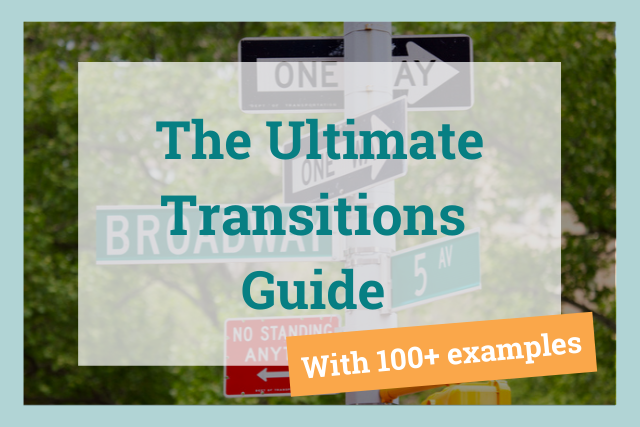
Imagine a road with no street signs to point the way. How would you follow the right route if you didn’t have a sign showing you which way to go?
Words and phrases like similarly , nevertheless , in order to , likewise , and as a result show the relationships between your ideas and can help illustrate agreement, contrast, or cause and effect.
What Are Transition Words?
Transition words are the road signs in writing. They help readers follow your train of thought without becoming bogged down trying to discern your meaning.
When used correctly, they keep up the flow of your writing as you shift in meaning, tone, and ideas from one sentence or paragraph to another. Transition words clarify the relationship between what you just said and what you're about to say for your readers.
Here’s an example of a well-placed transition:
- Original: The boy kicked the ball into the street. A speeding car came around the corner.
- Rewrite: The boy kicked the ball into the street. At the same moment, a speeding car came around the corner.
The rewrite uses a transition phrase to show when the event happened. We see the action in a wider lens: the ball goes into the street just as a car comes careening around the corner. The first illustration is short and choppy. It doesn’t flow well. The rewrite leads you smoothly between two related, but different thoughts.
The addition of at the same moment also clarifies the connection between the ideas for the reader. Since we know these events are connected and happening at the same time, we feel more tension for what's about to happen.
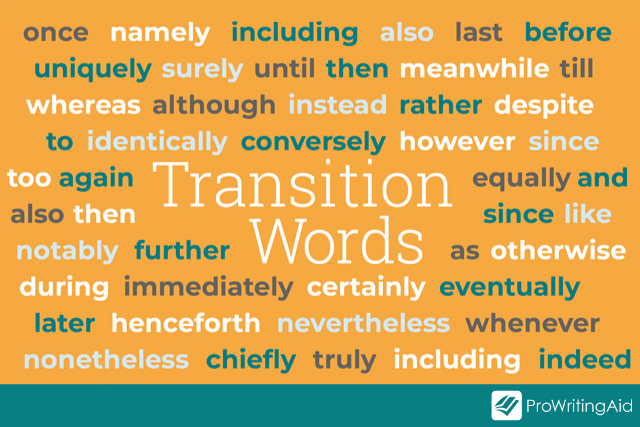
Transitional Words Examples: Fiction
Let’s take a look at some of these words in context to better examine how they work.
Fiction Transitions Example 1:
Take the following two sentences. Which one reads more fluidly?
- Mark tended to avoid the campus dining hall where his former friends hung out. He loved its food.
- Mark tended to avoid the campus dining hall where his former friends hung out, although he loved its food.
In the second construction, you understand how the two ideas are related. The first construction reads as choppy, two disparate ideas connected solely by proximity. By adding the transition word although and combining the two sentences, the second construction makes it clear that avoiding the dining hall had consequences for Mark. It gives more meaning to both sentences.
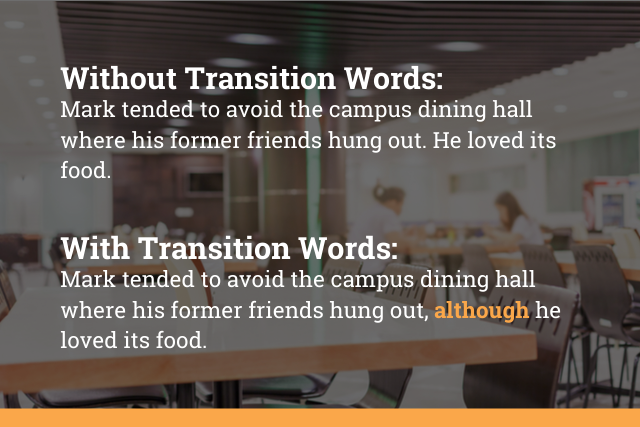
Fiction Transitions Example 2:
Here’s another example of transition word usage in fiction writing:
- Mindy thought her mother was over-reacting to her predicament. She waited two days after the first phone call to visit.
- Mindy thought her mother was over-reacting to her predicament. So, she waited two days after the first phone call to visit.
The use of so in the second construction makes clear to the reader that the gap in time between the call and the visit was a direct result of the over-reaction.
Transitional Words Examples: Non-Fiction
Transitions don’t just help fiction readers. Let’s take a look at how you can use transitions to improve your non-fiction writing.
Non-Fiction Transitions Example 1:
Take the following two constructions. Which one reads more fluidly?
- Marketing numbers have performed worse than we expected this year. We will be hiring a marketing consultant.
- Marketing numbers have performed worse than we expected this year, so we’ll be hiring a marketing consultant.
In the second construction, you understand how the two ideas are related. You see straight away that the poor marketing results are the direct reason for hiring a marketing consultant. By adding this connection, the relationship between the two ideas becomes clear. Similarly, the second version flows better and feels less self-contained.
Non-Fiction Transitions Example 2:
Here’s another example of transition word usage in non-fiction writing:
- The recent rise in oil pricing has made gas more expensive for consumers. Food prices have skyrocketed.
- The recent rise in oil pricing has made gas more expensive for consumers. Similarly, food prices have skyrocketed.
The use of similarly in the second construction makes it clear that there’s a relationship between the two ideas. The first construction feels disconnected since one sentence focuses on gas prices and another on food. The second construction makes it clear that the two ideas are related based on how they affect prices for consumers.
What Are the 6 Examples of Transitions?
What makes these phrases different from other words? They all move your writing from one idea to another.
The specific word or phrase you choose for your writing will depend on the type of transition you want to make. Each category of transition has multiple words or phrases you can choose from. Later in this article, we’ll show you hundreds of transition words or phrases to suit every need.
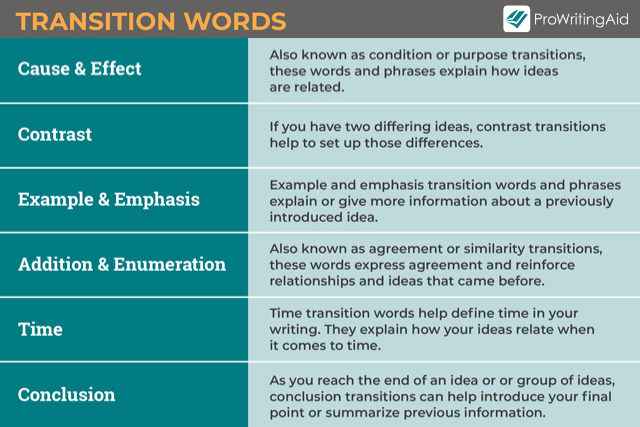
Before we get to the ultimate list of examples, let’s take a look at the categories.
Cause and effect: Show how two ideas are connected.
- I’m tired, so I’m going to bed.
Contrast: Show differences between two or more ideas.
- I hate most desserts. However, I love cookies.
Example and Emphasis: Introduce examples that help highlight or explain a previous point, or to add strength to a particular idea.
- I have a lot of fears. For instance, I’m terrified of spiders.
Addition & Enumeration: Break down, draw connections to, or add more support to an existing idea.
- Today, I’m going to do my homework. In addition, I’m going to clean my room.
Time: Explain how two or more ideas are related in time.
- Mary-Ann went out, looking for a bright new world. Meanwhile, Wanda looked all around their hometown and all she found was Earl.
Conclusion: Introduce a final point or summarize information.
- In conclusion, I deserve a new car because I’ve done all my chores for the month.
How ProWritingAid Can Help You with Transition Words
Clear, readable writing tends to use around 25% transition phrases. Of course this isn't set in stone—but if you have considerably fewer than this in your document, you may be losing your reader.
ProWritingAid's Transitions Report highlights all of the transition words in your document so you can see how your writing flows. Here's how it works:
Try out ProWritingAid's Transitions Report with a free account.
What Are Some Examples of Transition Words?
Looking for examples of transition words you can use in your writing? Look no further! We’ve put together the ultimate list with hundreds of examples you can use.
On to the list!
Cause and Effect Transition Phrases
Also known as condition or purpose transitions, these words and phrases explain how ideas are related.
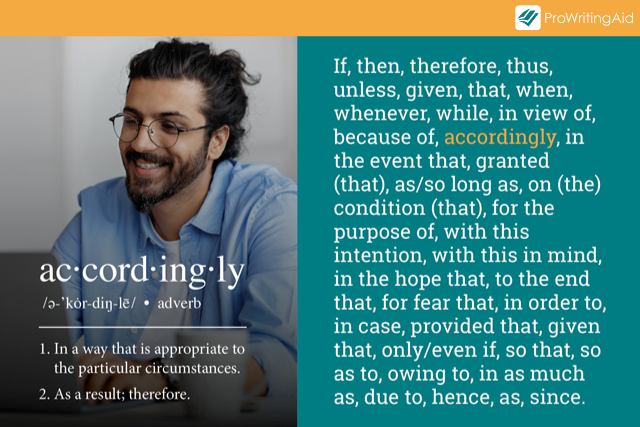
Contrast Transition Words
If you have two differing ideas, contrast transitions help to set up those differences.
Example and Emphasis Transition Words
Example and emphasis transition words and phrases explain or give more information about a previously introduced idea. Sometimes known as clarification transitions, these words help make your meaning more clear.
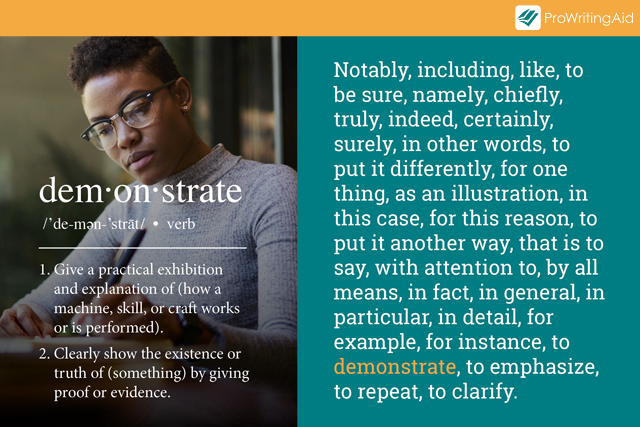
Addition and Enumeration Transition Words
Also known as agreement or similarity transitions, these words express agreement and reinforce relationships and ideas that came before.
Time Transition Words
Time transition words help define time in your writing. They explain how your ideas relate when it comes to time.
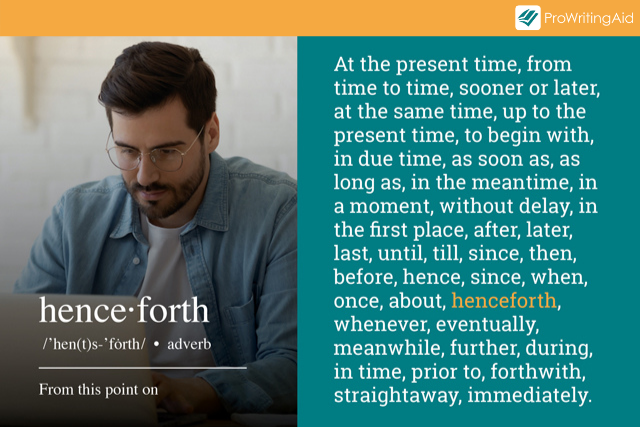
Conclusion Transitions
As you reach the end of an idea or or group of ideas, conclusion transitions can help introduce your final point or summarize previous information.
How to Use Transition Words More Effectively
Using transition words and phrases isn’t always as easy as it looks. Here are some best practices to keep in mind so that you can effectively use transition words.
1. Understand the relationship between your ideas
The better you understand the relationships between the ideas in your text, the more effectively you’ll be able to wield transition words and phrases. The relationships between your ideas will help you understand which you should pick.

2. Know your transition words
Different transitions are appropriate in different contexts. Don’t just pick a random transition to use. Make sure the one you’ve chosen is appropriate for what you’re trying to say. Also, don’t be afraid to try out a new transition word from the list we’ve provided above. Just like in other types of writing, repetitive language can be boring for your readers. Try out new transition words (as long as they’re the right type) to increase the interest of your writing.
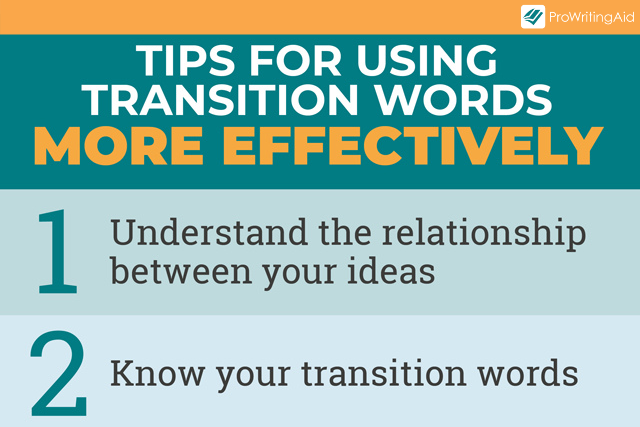
How ProWritingAid Helps You Improve Transition Words and Phrases in Your Writing
Since transitions help to organize your ideas and demonstrate connections, it’s important to include them in your writing to make it more clear. ProWritingAid can help. Our software analyzes your writing to determine whether or not you’ve used transitions appropriately in your work.
Depending on what you’re writing, you can find your Transitions score in two places: your goals and the Transition Report.
ProWritingAid knows that different genres require different amounts and types of transitions, so your suggested transition percentage changes depending on what you’re writing. If you’re working on an academic paper, for instance, transitional phrases are important to improving understanding. So you’ll find a goal for transitions in your sidebar.
On the other hand, formal transitions are less common in some types of fiction writing, so you may not see this goal if you’re working on say, a crime novel.
You can always find your score, regardless of what you’re writing, by running the Transition Report. The ProWritingAid Transition Report will scan your writing and give you a “transitions score." This measures the percentage of your sentences that begin with a transition word.
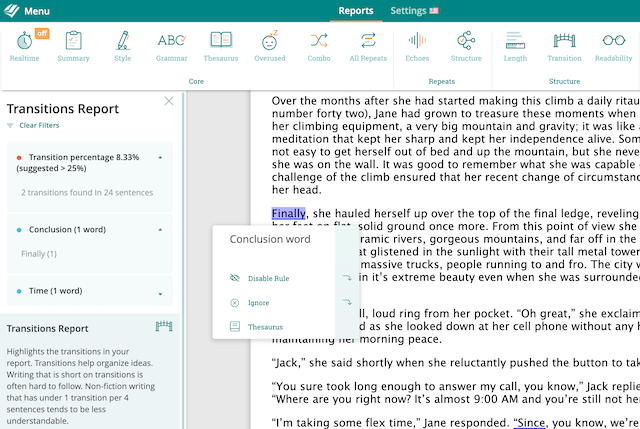
Check your transitions with a free ProWritingAid account.
Transitions: The Links Between Ideas
To conclude, great transitions lead to more sophisticated structure. (See what we did there with that transition?!)
Adding transitions to your writing creates clear connections for your readers. By adding transitions, you’ll help your readers better understand what you’re trying to say.
Happy writing!
Looking for more great editing advice? Download this FREE eBook:

Book cover: 20 Editing Tips From Professional Writers
Whether you are writing a novel, essay, article, or email, good writing is an essential part of communicating your ideas., this guide contains the 20 most important writing tips and techniques from a wide range of professional writers., common questions about transition words and phrases in english, transition usage, learn more about grammar:, your personal writing coach.
A grammar guru, style editor, and writing mentor in one package.
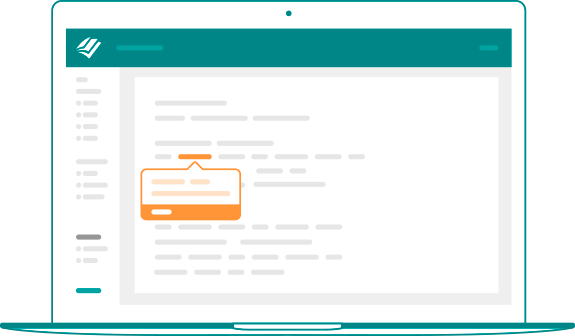
Drop us a line or let's stay in touch via :

Transitions
What this handout is about.
In this crazy, mixed-up world of ours, transitions glue our ideas and our essays together. This handout will introduce you to some useful transitional expressions and help you employ them effectively.
The function and importance of transitions
In both academic writing and professional writing, your goal is to convey information clearly and concisely, if not to convert the reader to your way of thinking. Transitions help you to achieve these goals by establishing logical connections between sentences, paragraphs, and sections of your papers. In other words, transitions tell readers what to do with the information you present to them. Whether single words, quick phrases, or full sentences, they function as signs that tell readers how to think about, organize, and react to old and new ideas as they read through what you have written.
Transitions signal relationships between ideas—relationships such as: “Another example coming up—stay alert!” or “Here’s an exception to my previous statement” or “Although this idea appears to be true, here’s the real story.” Basically, transitions provide the reader with directions for how to piece together your ideas into a logically coherent argument. Transitions are not just verbal decorations that embellish your paper by making it sound or read better. They are words with particular meanings that tell the reader to think and react in a particular way to your ideas. In providing the reader with these important cues, transitions help readers understand the logic of how your ideas fit together.
Signs that you might need to work on your transitions
How can you tell whether you need to work on your transitions? Here are some possible clues:
- Your instructor has written comments like “choppy,” “jumpy,” “abrupt,” “flow,” “need signposts,” or “how is this related?” on your papers.
- Your readers (instructors, friends, or classmates) tell you that they had trouble following your organization or train of thought.
- You tend to write the way you think—and your brain often jumps from one idea to another pretty quickly.
- You wrote your paper in several discrete “chunks” and then pasted them together.
- You are working on a group paper; the draft you are working on was created by pasting pieces of several people’s writing together.
Organization
Since the clarity and effectiveness of your transitions will depend greatly on how well you have organized your paper, you may want to evaluate your paper’s organization before you work on transitions. In the margins of your draft, summarize in a word or short phrase what each paragraph is about or how it fits into your analysis as a whole. This exercise should help you to see the order of and connection between your ideas more clearly.
If after doing this exercise you find that you still have difficulty linking your ideas together in a coherent fashion, your problem may not be with transitions but with organization. For help in this area (and a more thorough explanation of the “reverse outlining” technique described in the previous paragraph), please see the Writing Center’s handout on organization .
How transitions work
The organization of your written work includes two elements: (1) the order in which you have chosen to present the different parts of your discussion or argument, and (2) the relationships you construct between these parts. Transitions cannot substitute for good organization, but they can make your organization clearer and easier to follow. Take a look at the following example:
El Pais , a Latin American country, has a new democratic government after having been a dictatorship for many years. Assume that you want to argue that El Pais is not as democratic as the conventional view would have us believe.
One way to effectively organize your argument would be to present the conventional view and then to provide the reader with your critical response to this view. So, in Paragraph A you would enumerate all the reasons that someone might consider El Pais highly democratic, while in Paragraph B you would refute these points. The transition that would establish the logical connection between these two key elements of your argument would indicate to the reader that the information in paragraph B contradicts the information in paragraph A. As a result, you might organize your argument, including the transition that links paragraph A with paragraph B, in the following manner:
Paragraph A: points that support the view that El Pais’s new government is very democratic.
Transition: Despite the previous arguments, there are many reasons to think that El Pais’s new government is not as democratic as typically believed.
Paragraph B: points that contradict the view that El Pais’s new government is very democratic.
In this case, the transition words “Despite the previous arguments,” suggest that the reader should not believe paragraph A and instead should consider the writer’s reasons for viewing El Pais’s democracy as suspect.
As the example suggests, transitions can help reinforce the underlying logic of your paper’s organization by providing the reader with essential information regarding the relationship between your ideas. In this way, transitions act as the glue that binds the components of your argument or discussion into a unified, coherent, and persuasive whole.
Types of transitions
Now that you have a general idea of how to go about developing effective transitions in your writing, let us briefly discuss the types of transitions your writing will use.
The types of transitions available to you are as diverse as the circumstances in which you need to use them. A transition can be a single word, a phrase, a sentence, or an entire paragraph. In each case, it functions the same way: First, the transition either directly summarizes the content of a preceding sentence, paragraph, or section or implies such a summary (by reminding the reader of what has come before). Then, it helps the reader anticipate or comprehend the new information that you wish to present.
- Transitions between sections: Particularly in longer works, it may be necessary to include transitional paragraphs that summarize for the reader the information just covered and specify the relevance of this information to the discussion in the following section.
- Transitions between paragraphs: If you have done a good job of arranging paragraphs so that the content of one leads logically to the next, the transition will highlight a relationship that already exists by summarizing the previous paragraph and suggesting something of the content of the paragraph that follows. A transition between paragraphs can be a word or two (however, for example, similarly), a phrase, or a sentence. Transitions can be at the end of the first paragraph, at the beginning of the second paragraph, or in both places.
- Transitions within paragraphs: As with transitions between sections and paragraphs, transitions within paragraphs act as cues by helping readers to anticipate what is coming before they read it. Within paragraphs, transitions tend to be single words or short phrases.
Transitional expressions
Effectively constructing each transition often depends upon your ability to identify words or phrases that will indicate for the reader the kind of logical relationships you want to convey. The table below should make it easier for you to find these words or phrases. Whenever you have trouble finding a word, phrase, or sentence to serve as an effective transition, refer to the information in the table for assistance. Look in the left column of the table for the kind of logical relationship you are trying to express. Then look in the right column of the table for examples of words or phrases that express this logical relationship.
Keep in mind that each of these words or phrases may have a slightly different meaning. Consult a dictionary or writer’s handbook if you are unsure of the exact meaning of a word or phrase.
You may reproduce it for non-commercial use if you use the entire handout and attribute the source: The Writing Center, University of North Carolina at Chapel Hill
Make a Gift
Writing Studio
Common transition words and phrases.
In an effort to make our handouts more accessible, we have begun converting our PDF handouts to web pages. Download this page as a PDF: Transitions Return to Writing Studio Handouts
Transitions clarify the logic of your argument by orienting your reader as you develop ideas between sentences and paragraphs. These tools should alert readers to shifts in your argument while and also maintain the smoothness and clarity of your prose. Below, you’ll find some of the most commonly used transition categories and examples of each. Depending on the example, these suggestions may be within sentences or at the beginning of sentences.
Transitions by Category
1. addition.
Use when presenting multiple ideas that flow in the same direction, under the same heading/ idea also, another, finally, first, first of all, for one thing, furthermore, in addition, last of all, likewise, moreover, next, and, second, the third reason
2. Sequence/ Order
Use to suggest a temporal relationship between ideas; places evidence in sequence first, second (etc.), next, last, finally, first of all, concurrently, immediately, prior to, then, at that time, at this point, previously, subsequently, and then, at this time, thereafter, previously, soon, before, after, followed by, after that, next, before, after, meanwhile, formerly, finally, during
3. Contrast
Use to demonstrate differences between ideas or change in argument direction but, however, in contrast, on the other hand, on the contrary, yet, differ, difference, balanced against, differing from, variation, still, on the contrary, unlike, conversely, otherwise, on the other hand, however
4. Exception
Use to introduce an opposing idea however, whereas, on the other hand, while, instead, in spite of, yet, despite, still, nevertheless, even though, in contrast, but, but one could also say…
5. Comparison
Use to demonstrate similarities between ideas that may not be under the same subject heading or within the same paragraph like, likewise, just, in a different way / sense, whereas, like, equally, in like manner, by comparison, similar to, in the same way, alike, similarity, similarly, just as, as in a similar fashion, conversely
6. Illustration
Use to develop or clarify an idea, to introduce examples, or to show that the second idea is subordinate to the first for example, to illustrate, on this occasion, this can be seen, in this case, specifically, once, to illustrate, when/where, for instance, such as, to demonstrate, take the case of, in this case
7. Location
Use to show spatial relations next to, above, below, beneath, left, right, behind, in front, on top, within
8. Cause and Effect
Use to show that one idea causes, or results from, the idea that follows or precedes it because, therefore, so that, cause, reason, effect, thus, consequently, since, as a result, if…then, result in
9. Emphasis
Use to suggest that an idea is particularly important to your argument important to note, most of all, a significant factor, a primary concern, a key feature, remember that, pay particular attention to, a central issue, the most substantial issue, the main value, a major event, the chief factor, a distinctive quality, especially valuable, the chief outcome, a vital force, especially relevant, most noteworthy, the principal item, above all, should be noted
10. Summary or Conclusion
Use to signal that what follows is summarizing or concluding the previous ideas; in humanities papers, use these phrases sparingly. to summarize, in short, in brief, in sum, in summary, to sum up, in conclusion, to conclude, finally
Some material adapted from Cal Poly Pomona College Reading Skills Program and “ Power Tools for Technical Communication .”
Writing Effective Sentence Transitions (Advanced)
Transitions are the rhetorical tools that clarify the logic of your argument by orienting your reader as you develop ideas between sentences and paragraphs. The ability to integrate sentence transitions into your prose, rather than simply throwing in overt transition signals like “in addition,” indicates your mastery of the material. (Note: The visibility of transitions may vary by discipline; consult with your professor to get a better sense of discipline or assignment specific expectations.)
Transition Signals
Transition signals are words or phrases that indicate the logic connecting sets of information or ideas. Signals like therefore, on the other hand, for example, because, then, and afterwards can be good transition tools at the sentence and paragraph level. When using these signals, be conscious of the real meaning of these terms; they should reflect the actual relationship between ideas.
Review Words
Review words are transition tools that link groups of sentences or whole paragraphs. They condense preceding discussion into a brief word or phrase. For example: You’ve just completed a detailed discussion about the greenhouse effect. To transition to the next topic, you could use review words like “this heat-trapping process” to refer back to the green house effect discussion. The relative ability to determine a cogent set of review words might signal your own understanding of your work; think of review words as super-short summaries of key ideas.
Preview words
Preview words condense an upcoming discussion into a brief word or phrase. For example: You’ve just explained how heat is trapped in the earth’s atmosphere. Transitioning to the theory that humans are adding to that effect, you could use preview words like “sources of additional CO2 in the atmosphere include” to point forward to that discussion.
Transition Sentences
The strongest and most sophisticated tools, transition sentences indicate the connection between the preceding and upcoming pieces of your argument. They often contain one or more of the above transition tools. For example: You’ve just discussed how much CO2 humans have added to the atmosphere. You need to transition to a discussion of the effects. A strong set of transition sentences between the two sections might sound like this:
“These large amounts of CO2 added to the atmosphere may lead to a number of disastrous consequences for residents of planet earth. The rise in global temperature that accompanies the extra CO2 can yield effects as varied as glacial melting and species extinction.”
In the first sentence, the review words are “These large amounts of CO2 added to the atmosphere”; the preview words are “number of disastrous consequences”; the transition signals are “may lead to.” The topic sentence of the next paragraph indicates the specific “disastrous consequences” you will discuss.
If you don’t see a way to write a logical, effective transition between sentences, ideas or paragraphs, this might indicate organizational problems in your essay; you might consider revising your work.
Some material adapted from Cal Poly Pomona College Reading Skills Program and “ Power Tools for Technical Communication .”
Last revised: 07/2008 | Adapted for web delivery: 05/2021
In order to access certain content on this page, you may need to download Adobe Acrobat Reader or an equivalent PDF viewer software.
Some experts argue that focusing on individual actions to combat climate change takes the focus away from the collective action required to keep carbon levels from rising. Change will not be effected, say some others, unless individual actions raise the necessary awareness.
While a reader can see the connection between the sentences above, it’s not immediately clear that the second sentence is providing a counterargument to the first. In the example below, key “old information” is repeated in the second sentence to help readers quickly see the connection. This makes the sequence of ideas easier to follow.
Sentence pair #2: Effective Transition
Some experts argue that focusing on individual actions to combat climate change takes the focus away from the collective action required to keep carbon levels from rising. Other experts argue that individual actions are key to raising the awareness necessary to effect change.
You can use this same technique to create clear transitions between paragraphs. Here’s an example:
Some experts argue that focusing on individual actions to combat climate change takes the focus away from the collective action required to keep carbon levels from rising. Other experts argue that individual actions are key to raising the awareness necessary to effect change. According to Annie Lowery, individual actions are important to making social change because when individuals take action, they can change values, which can lead to more people becoming invested in fighting climate change. She writes, “Researchers believe that these kinds of household-led trends can help avert climate catastrophe, even if government and corporate actions are far more important” (Lowery).
So, what’s an individual household supposed to do?
The repetition of the word “household” in the new paragraph helps readers see the connection between what has come before (a discussion of whether household actions matter) and what is about to come (a proposal for what types of actions households can take to combat climate change).
Sometimes, transitional words can help readers see how ideas are connected. But it’s not enough to just include a “therefore,” “moreover,” “also,” or “in addition.” You should choose these words carefully to show your readers what kind of connection you are making between your ideas.
To decide which transitional word to use, start by identifying the relationship between your ideas. For example, you might be
- making a comparison or showing a contrast Transitional words that compare and contrast include also, in the same way, similarly, in contrast, yet, on the one hand, on the other hand. But before you signal comparison, ask these questions: Do your readers need another example of the same thing? Is there a new nuance in this next point that distinguishes it from the previous example? For those relationships between ideas, you might try this type of transition: While x may appear the same, it actually raises a new question in a slightly different way.
- expressing agreement or disagreement When you are making an argument, you need to signal to readers where you stand in relation to other scholars and critics. You may agree with another person’s claim, you may want to concede some part of the argument even if you don’t agree with everything, or you may disagree. Transitional words that signal agreement, concession, and disagreement include however, nevertheless, actually, still, despite, admittedly, still, on the contrary, nonetheless .
- showing cause and effect Transitional phrases that show cause and effect include therefore, hence, consequently, thus, so. Before you choose one of these words, make sure that what you are about to illustrate is really a causal link. Novice writers tend to add therefore and hence when they aren’t sure how to transition; you should reserve these words for when they accurately signal the progression of your ideas.
- explaining or elaborating Transitions can signal to readers that you are going to expand on a point that you have just made or explain something further. Transitional words that signal explanation or elaboration include in other words, for example, for instance, in particular, that is, to illustrate, moreover .
- drawing conclusions You can use transitions to signal to readers that you are moving from the body of your argument to your conclusions. Before you use transitional words to signal conclusions, consider whether you can write a stronger conclusion by creating a transition that shows the relationship between your ideas rather than by flagging the paragraph simply as a conclusion. Transitional words that signal a conclusion include in conclusion , as a result, ultimately, overall— but strong conclusions do not necessarily have to include those phrases.
If you’re not sure which transitional words to use—or whether to use one at all—see if you can explain the connection between your paragraphs or sentence either out loud or in the margins of your draft.
For example, if you write a paragraph in which you summarize physician Atul Gawande’s argument about the value of incremental care, and then you move on to a paragraph that challenges those ideas, you might write down something like this next to the first paragraph: “In this paragraph I summarize Gawande’s main claim.” Then, next to the second paragraph, you might write, “In this paragraph I present a challenge to Gawande’s main claim.” Now that you have identified the relationship between those two paragraphs, you can choose the most effective transition between them. Since the second paragraph in this example challenges the ideas in the first, you might begin with something like “but,” or “however,” to signal that shift for your readers.
- picture_as_pdf Transitions
Transitional Expressions
Glossary of Grammatical and Rhetorical Terms
- An Introduction to Punctuation
- Ph.D., Rhetoric and English, University of Georgia
- M.A., Modern English and American Literature, University of Leicester
- B.A., English, State University of New York
A transitional expression is a word or phrase that shows how the meaning of one sentence is related to the meaning of the preceding sentence. Also called a transition , transitional word, or signal word .
Though important for establishing cohesion in a text, transitional expressions can be overworked to the point that they distract readers. "Overuse of these signals can seem heavy-handed," says Diane Hacker. "Usually, you will use transitions quite naturally, just where readers need them" ( The Bedford Handbook , 2013).
A transitional expression can be useful for making a text or a speech flow well, with clear connections between ideas. However, inexperienced writers will often use these phrases too often, peppering them in every sentence or multiple times in a single sentence, which can actually have the opposite effect: confusing readers or obscuring the point, rather than clarifying the point.
Examples and Observations
- " Far to his left , in the northeast, beyond the valley and the terraced foothills of the Sierra Madre Oriental, the two volcanoes , Popocatepetl and Ixtaccihuatl, rose clear and magnificent into the sunset. Nearer , perhaps ten miles distant, and on a lower level than the main valley, he made out the village of Tomalín, nestling behind the jungle, from which rose a thin blue scarf of illegal smoke, someone burning wood for carbon. Before him, on the other side of the American highway, spread fields and groves, through which meandered a river, and the Alcapancingo road." (Malcolm Lowry, Under the Volcano , 1947)
- "The secret is that our holidays should rest not only our minds and bodies but our characters too. Take, for example , a good man. His goodness wants a holiday as much as his poor weary head or his exhausted body." (E.V. Lucas, "The Perfect Holiday," 1912)
- " Over the years his family had turned ironical and lost its gift for action. It was an honorable and violent family, but eventually the violence had been deflected and turned inward." (Walker Percy, The Last Gentleman, 1966)
- "Santayana was the last aesthetician to describe beauty without self-consciousness; and that was in 1896. As a result , we now live in a relativist's world where one man's beauty is another man's beast." (Gore Vidal, "On Prettiness," 1978)
- "If Larry shoots field goals at 0.6 probability of success, he will get five in a row about once every thirteen sequences (0.65). If Joe, by contrast , shoots only 0.3, he will get his five straight only about once in 412 times. In other words , we need no special explanation for the apparent pattern of long runs." (Stephen Jay Gould, "The Streak of Streaks," 1988)
- Using But as a Transitional Expression "Learn to alert the reader as soon as possible to any change in mood from the previous sentence. At least a dozen words will do the job for you: 'but,' 'yet,' 'however,' 'nevertheless,' 'still,' 'instead,' 'thus,' 'therefore,' 'meanwhile,' 'now,' 'later,' 'today,' 'subsequently,' and several more. I can't overstate how much easier it is for readers to process a sentence if you start with 'but' when you're shifting direction. . . . "Many of us were taught that no sentence should begin with 'but.' If that's what you learned, unlearn it--there's no stronger word at the start." (William Zinsser, On WritingWell , Collins, 2006)
- Using Specific Transitions " Transitional expressions within a paragraph and between paragraphs help the reader move from one detail or supporting point in an essay to the next. When first learning to organize an essay, beginning writers may start each body paragraph and every new example with a transitional expression ( first, for example, next ). These common transitions are useful and clear, but they can sound mechanical. To improve the flow of your ideas and the strength of your written voice , try to replace some of these expressions with specific phrases ( at the start of the meeting or in some people's minds ) or with dependent clauses ( when drivers use cell phones or as I approached the intersection )." (Paige Wilson and Teresa Ferster Glazier, The Least You Should Know about English, Form A: Writing Skills , 11th ed. Wadsworth, 2012)
- "It turns out . . ." "Incidentally, am I alone in finding the expression ‘it turns out’ to be incredibly useful? It allows you to make swift, succinct, and authoritative connections between otherwise randomly unconnected statements without the trouble of explaining what your source or authority actually is. It’s great. It’s hugely better than its predecessors ‘I read somewhere that . . .' or the craven 'they say that . . .' because it suggests not only that whatever flimsy bit of urban mythology you are passing on is actually based on brand new, ground breaking research, but that it is research in which you yourself were intimately involved. But again, with no actual authority anywhere in sight." (Douglas Adams, "Hangover Cures." The Salmon of Doubt: Hitchhiking the Galaxy One Last Time . Macmillan, 2002)
Related Concepts
- Cohesion Exercise: Combining and Connecting Sentences
- Cohesion Strategies: A List of Transitional Words and Phrases
- Sample Paragraphs: Junk Food Junkie and Confessions of a Slob
- Paragraph Transition
- Transitional Paragraph
- Definition and Examples of a Transition in Composition
- Complete List of Transition Words
- Definition and Examples of Paragraphing in Essays
- How to Teach Topic Sentences Using Models
- Paragraph Transition: Definition and Examples
- Definition and Examples of Transitional Paragraphs
- The Ultimate Guide to the 5-Paragraph Essay
- Definition and Examples of Paragraph Breaks in Prose
- Paragraph Length in Compositions and Reports
- Paragraph Writing
- Editing and Proofreading Marks in Composition
- Writers on Writing: The Art of Paragraphing
- Make Your Paragraphs Flow to Improve Writing
- Definition and Examples of Complex Prepositions
- Garden-path Sentence
- Best Practices for the Most Effective Use of Paragraphs
Transitional Words and Phrases
One of your primary goals as a writer is to present ideas in a clear and understandable way. To help readers move through your complex ideas, you want to be intentional about how you structure your paper as a whole as well as how you form the individual paragraphs that comprise it. In order to think through the challenges of presenting your ideas articulately, logically, and in ways that seem natural to your readers, check out some of these resources: Developing a Thesis Statement , Paragraphing , and Developing Strategic Transitions: Writing that Establishes Relationships and Connections Between Ideas.
While clear writing is mostly achieved through the deliberate sequencing of your ideas across your entire paper, you can guide readers through the connections you’re making by using transitional words in individual sentences. Transitional words and phrases can create powerful links between your ideas and can help your reader understand your paper’s logic.
In what follows, we’ve included a list of frequently used transitional words and phrases that can help you establish how your various ideas relate to each other. We’ve divided these words and phrases into categories based on the common kinds of relationships writers establish between ideas.
Two recommendations: Use these transitions strategically by making sure that the word or phrase you’re choosing matches the logic of the relationship you’re emphasizing or the connection you’re making. All of these words and phrases have different meanings, nuances, and connotations, so before using a particular transitional word in your paper, be sure you understand its meaning and usage completely, and be sure that it’s the right match for your paper’s logic. Use these transitional words and phrases sparingly because if you use too many of them, your readers might feel like you are overexplaining connections that are already clear.
Categories of Transition Words and Phrases
Causation Chronology Combinations Contrast Example
Importance Location Similarity Clarification Concession
Conclusion Intensification Purpose Summary
Transitions to help establish some of the most common kinds of relationships
Causation– Connecting instigator(s) to consequence(s).
accordingly as a result and so because
consequently for that reason hence on account of
since therefore thus
Chronology– Connecting what issues in regard to when they occur.
after afterwards always at length during earlier following immediately in the meantime
later never next now once simultaneously so far sometimes
soon subsequently then this time until now when whenever while
Combinations Lists– Connecting numerous events. Part/Whole– Connecting numerous elements that make up something bigger.
additionally again also and, or, not as a result besides even more
finally first, firstly further furthermore in addition in the first place in the second place
last, lastly moreover next second, secondly, etc. too
Contrast– Connecting two things by focusing on their differences.
after all although and yet at the same time but
despite however in contrast nevertheless nonetheless notwithstanding
on the contrary on the other hand otherwise though yet
Example– Connecting a general idea to a particular instance of this idea.
as an illustration e.g., (from a Latin abbreviation for “for example”)
for example for instance specifically that is
to demonstrate to illustrate
Importance– Connecting what is critical to what is more inconsequential.
chiefly critically
foundationally most importantly
of less importance primarily
Location– Connecting elements according to where they are placed in relationship to each other.
above adjacent to below beyond
centrally here nearby neighboring on
opposite to peripherally there wherever
Similarity– Connecting to things by suggesting that they are in some way alike.
by the same token in like manner
in similar fashion here in the same way
likewise wherever
Other kinds of transitional words and phrases Clarification
i.e., (from a Latin abbreviation for “that is”) in other words
that is that is to say to clarify to explain
to put it another way to rephrase it
granted it is true
naturally of course
finally lastly
in conclusion in the end
to conclude
Intensification
in fact indeed no
of course surely to repeat
undoubtedly without doubt yes
for this purpose in order that
so that to that end
to this end
in brief in sum
in summary in short
to sum up to summarize

Improving Your Writing Style
This is an accordion element with a series of buttons that open and close related content panels.
Clear, Concise Sentences
Use the active voice
Put the action in the verb
Tidy up wordy phrases
Reduce wordy verbs
Reduce prepositional phrases
Reduce expletive constructions
Avoid using vague nouns
Avoid unneccessarily inflated words
Avoid noun strings
Connecting Ideas Through Transitions
Using Transitional Words and Phrases
- More from M-W
- To save this word, you'll need to log in. Log In
Definition of transition
(Entry 1 of 2)
Note: While many associate this meaning of transition with a process that involves hormone therapy, gender confirmation surgery , and legal name change, the term is also applied more broadly, since what transition involves can vary a great deal from person to person. In some cases, for example, the word transition may simply refer to the adoption of new personal pronouns and/or a change in clothing, hairstyle, etc.
Definition of transition (Entry 2 of 2)
Examples of transition in a Sentence
These examples are programmatically compiled from various online sources to illustrate current usage of the word 'transition.' Any opinions expressed in the examples do not represent those of Merriam-Webster or its editors. Send us feedback about these examples.
Word History
Latin transition-, transitio , from transire
1545, in the meaning defined at sense 1a
1877, in the meaning defined at sense 1
Phrases Containing transition
- gender transition
- in transition
- transition period
- transition metal
Articles Related to transition

Merriam-Webster's Short List of Gender...
Merriam-Webster's Short List of Gender and Identity Terms
In case you (or someone you know) has questions about what they mean
Dictionary Entries Near transition
transit instrument
transitional
Cite this Entry
“Transition.” Merriam-Webster.com Dictionary , Merriam-Webster, https://www.merriam-webster.com/dictionary/transition. Accessed 31 Mar. 2024.
Kids Definition
Kids definition of transition.
Kids Definition of transition (Entry 2 of 2)
Medical Definition
Medical definition of transition.
Medical Definition of transition (Entry 2 of 2)
More from Merriam-Webster on transition
Thesaurus: All synonyms and antonyms for transition
Nglish: Translation of transition for Spanish Speakers
Britannica English: Translation of transition for Arabic Speakers
Britannica.com: Encyclopedia article about transition
Subscribe to America's largest dictionary and get thousands more definitions and advanced search—ad free!

Can you solve 4 words at once?
Word of the day.
See Definitions and Examples »
Get Word of the Day daily email!
Popular in Grammar & Usage
The tangled history of 'it's' and 'its', more commonly misspelled words, commonly misspelled words, how to use em dashes (—), en dashes (–) , and hyphens (-), absent letters that are heard anyway, popular in wordplay, the words of the week - mar. 29, 9 superb owl words, 'gaslighting,' 'woke,' 'democracy,' and other top lookups, 10 words for lesser-known games and sports, your favorite band is in the dictionary, games & quizzes.


IMAGES
VIDEO
COMMENTS
Learn how to use transition sentences to connect your ideas and structure your text. Find out the different types of transitions, when to use them, and how to avoid overusing them.
Learn what transition sentences are and how to use them to link your ideas in writing. Find out the common words, phrases, and categories of transition sentences with examples and tips.
By adding the transition word although and combining the two sentences, the second construction makes it clear that avoiding the dining hall had consequences for Mark. It gives more meaning to both sentences. Fiction Transitions Example 2: Here's another example of transition word usage in fiction writing:
Transition sentences serve various functions in writing, such as highlighting relationships between ideas, including similarity, contrast, sequence, time, examples, emphasis, and cause/effect. They can be used to transition between main ideas in different paragraphs, outlining how one paragraph's ideas relate to the next, or even within ...
Transition words and phrases Sentence transitions. By using common transition words in sentences, writers can accomplish the following: Detail the logical relationship that exists between the previous argument or sentence and what follows. Provide readers with a blueprint for how to combine the ideas to understand the purpose of the essay.
A transition between paragraphs can be a word or two (however, for example, similarly), a phrase, or a sentence. Transitions can be at the end of the first paragraph, at the beginning of the second paragraph, or in both places. Transitions within paragraphs: As with transitions between sections and paragraphs, transitions within paragraphs act ...
Transition Sentences What Are Transition Sentences? A transition is simply a word, phrase, or sentence, that helps the reader identify a clear and well-structured connection between ideas.Using transitions throughout your writing is especially important when it comes to writing for professional and academic purposes, as your main goal when writing is to share information or ideas with clarity.
Transitions are the rhetorical tools that clarify the logic of your argument by orienting your reader as you develop ideas between sentences and paragraphs. The ability to integrate sentence transitions into your prose, rather than simply throwing in overt transition signals like "in addition," indicates your mastery of the material.
Transition sentences are crucial to the flow of a paper and for clear comprehension. They help guide a reader through a piece of research; its findings and arguments. They also help to understand how central ideas in your paper are connected. As such, transition sentences are used to structure paragraphs and link up sections.
Sequential transition words. Sequential transition words are useful when outlining a step-by-step process or a sequence of events. They help readers understand the time, order, and sequence of your ideas. Some good examples include "then," "first," "in addition," "subsequently," "afterward," "to begin with," "second ...
A transition is the act of moving from one state to another. In this sense, transition words are the words and phrases writers use to connect different ideas. They carry a thought from one idea to ...
- Definition. A transition sentence is a statement that connects one idea or paragraph to the next. It serves as a smooth bridge, ensuring that readers can seamlessly move from one point to another without feeling jarred or lost. Essentially, it's the linking thread that weaves various parts of content together, giving your writing a ...
Two sentences become a sentence, using transitions words or phrases that link sentences and paragraphs together smoothly so that there are no abrupt jumps or breaks between ideas. Here is a list of some common transition word that can be helpful for writer to use the word to link two sentences. ... Granted that Bob promised to send some money ...
Transitional terms give writers the opportunity to prepare readers for a new idea, connecting the previous sentence to the next one. Many transitional words are nearly synonymous: words that broadly indicate that "this follows logically from the preceding" include accordingly, therefore, and consequently.Words that mean "in addition to" include moreover, besides, and further.
Transitions. Transitions help your readers move between ideas within a paragraph, between paragraphs, or between sections of your argument. When you are deciding how to transition from one idea to the next, your goal should be to help readers see how your ideas are connected—and how those ideas connect to the big picture.
Definition of Transition. Transitions are words and phrases that provide a connection between ideas, sentences, and paragraphs. Transitions help to make a piece of writing flow better. They can turn disconnected pieces of ideas into a unified whole, and prevent a reader from getting lost in the storyline.
Glossary of Grammatical and Rhetorical Terms. Transitional expressions are sometimes called signposts. (Emma Kim/Getty Images) A transitional expression is a word or phrase that shows how the meaning of one sentence is related to the meaning of the preceding sentence. Also called a transition, transitional word, or signal word .
Transitional words and phrases can create powerful links between ideas in your paper and can help your reader understand the logic of your paper. However, these words all have different meanings, nuances, and connotations. Before using a particular transitional word in your paper, be sure you understand its meaning and usage completely and be sure…
transition: [noun] passage from one state, stage, subject, or place to another : change. a movement, development, or evolution from one form, stage, or style to another.